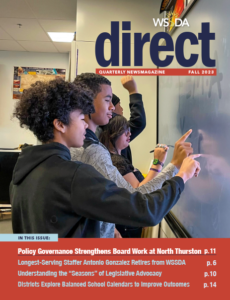Announcing the 2023 Boards of Distinction
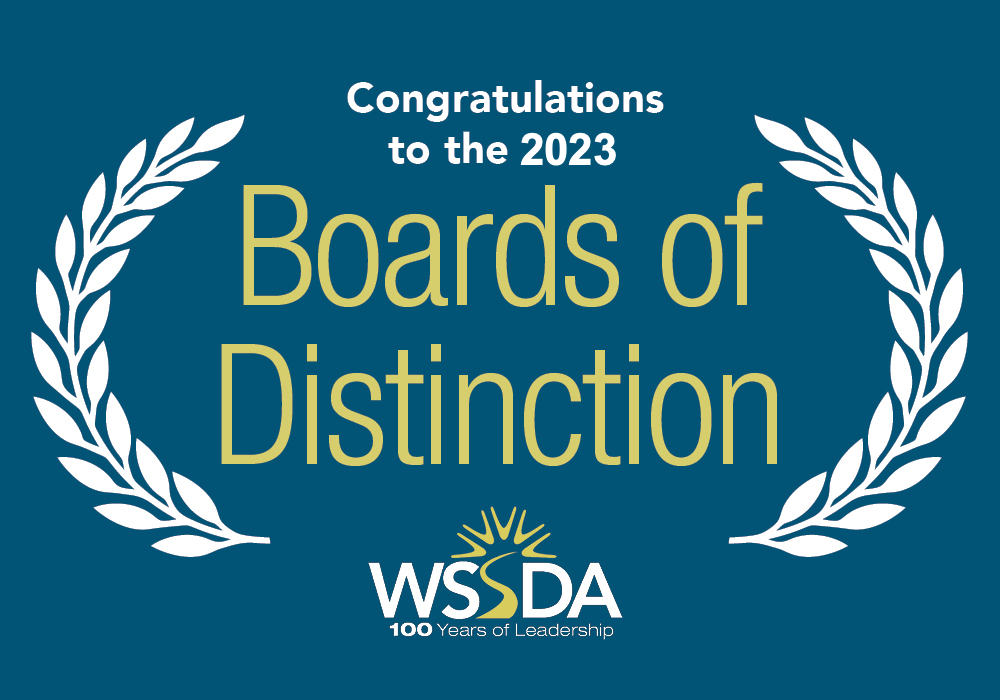
The Washington State School Directors’ Association (WSSDA) is proud to announce the distinguished winners of the 2023 WSSDA Boards of Distinction program. This prestigious recognition celebrates school boards across the state that have demonstrated exceptional leadership and commitment to student success. In this year’s program, 34 school boards, including several first-time applicants, have been honored as 2023 WSSDA Boards of Distinction.
These 34 school districts, representing a broad spectrum of size, ranging from a couple of hundred students to more than 30,000, all share a common commitment to ensuring student success. They have approached this goal through various strategies, including extensive strategic planning, data-driven analysis to understand student performance, and creating an environment conducive to the success of both students and staff.
“Each selected school board has shown a clear focus on assessing their students’ outcomes and exploring ways to enhance their leadership,” said WSSDA Director of Leadership Development Tricia Lubach. “As schools return to fully in-person instruction after a challenging couple of years, it is evident that these school boards have refocused their attention on closing opportunity gaps for students within their districts and committing to consistent communication with their communities.“
The Boards of Distinction program, initiated in 2009, aligns with the research-based Washington School Board Standards published in the same year. These standards guide school boards to focus on areas where they can make the most significant difference in supporting students, aligning with their community’s aspirations for its children, and effectively governing the school district. School boards seeking this honor must illustrate their implementation of a specific Washington school board standard and provide compelling evidence demonstrating a positive impact on closing opportunity gaps for their students.
A panel of reviewers, comprising members from the Washington State Board of Education and various Educational Service Districts across the state, meticulously evaluated the applications and selected those that exceeded the established criteria.
The grand finale of this celebration will culminate in the announcement of the three Boards of the Year at WSSDA’s 2023 Annual Conference, scheduled for November 18th. Selected from among the Boards of Distinction, the Boards of the Year will represent a small, medium, and large school district based on the number of students they serve. This prestigious honor will recognize the exceptional achievements of these school boards and the extraordinary leadership they have shown in driving the success of their students and their communities.
WSSDA is proud to applaud the commitment, dedication, and innovative approaches these Boards of Distinction demonstrate. Even the simple act of applying for the award shows they practiced self-reflection, analyzed data and other evidence, and held themselves accountable to specific goals. Every school board that works in that way may serve as a shining example of leadership in education, inspiring positive change and contributing to the betterment of the students and communities they serve.
The 2023 Boards of Distinction are:
Small District Category
- Cascade School District
- La Conner School District
- Mabton School District
- Meridian School District
- Morton School District
- Oakville School District
- South Whidbey School District
Medium District Category
- Anacortes School District
- Arlington School District
- Kelso School District
- Mount Vernon School District
- Peninsula School District
- Pullman School District
- Quincy School District
- Riverview School District
- Shelton School District
- University Place School District
- Walla Walla Public Schools
- Wapato School District
- White River School District
Large District Category
- Auburn School District
- Battle Ground School District
- Bellevue School District
- Edmonds School District
- Everett School District
- Federal Way School District
- Issaquah School District
- Lake Washington School District
- North Thurston Public Schools
- Northshore School District
- Pasco School District
- Puyallup School District
- Sumner-Bonney Lake School District
- Tacoma School District
Get the Fall Issue of WSSDA’s Quarterly Magazine
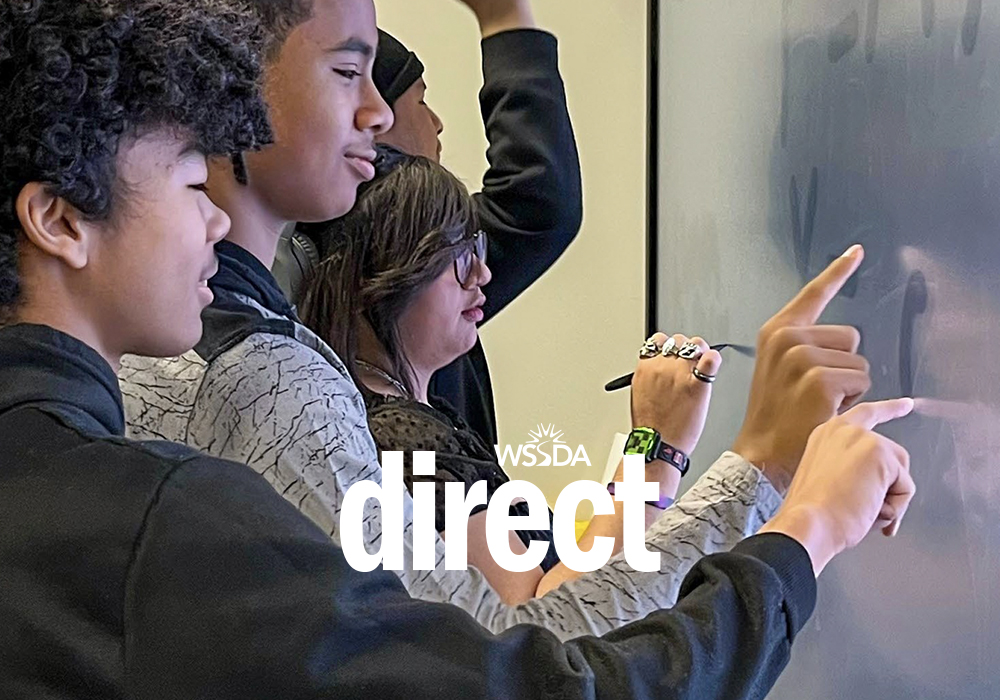
In this issue you’ll find a great story about one of last year’s Boards of the Year, North Thurston and their use of a Policy Governance approach; a fond farewell to WSSDA’s longest-serving staffer; insights about what a “balanced” school calendar is; and insights from a student board representative. All of that and more. Read the latest issue.
Districts Explore Balanced School Calendars to Improve Outcomes for Students

Across Washington, more than 45 school districts have studies or implementations underway for new balanced calendars that spread school breaks more evenly across the school year.
The primary aims of a balanced calendar are to reduce the number of consecutive days or weeks in a row that students are out of school, reduce the well-documented summer learning loss, and increase student learning overall. For these reasons, a redesigned school year is part of State Superintendent Chris Reykdal’s long-term vision for Washington’s K-12 public schools.
Educational leaders have long studied the potential benefits of modified school calendars. For example, a shorter summer break means less review time at the beginning of the school year and more time to teach new material. Balanced calendars also build in time for intensive learning opportunities called intersessions, which are held during school breaks. With intersessions occurring throughout the year, students who need additional support receive the help they need in a timely manner, which prevents them from falling even further behind. It also can reduce the need for summer school, which can have a stigma associated with it.
Several other benefits are also possible, and they will vary with the uniqueness of each district. Secondary benefits may include reducing transportation needs, creating the ability to accommodate celebrations or cultural events, and adjusting to local harvest schedules.
Research regarding the effectiveness of balanced calendars spans back to the 1980s, but the most seminal study on this subject was completed in 1996 with the work of Cooper, Nye, Charlton, Lindsey, and Greenhouse.1 Their meta-analysis found gains in student performance, and corroborating studies continue today.
The Pandemic Creates Both Need and Opportunity
Interest in balanced school calendars gained momentum after the pandemic disrupted learning and widened opportunity gaps. In 2021, the Office of Superintendent of Public Instruction (OSPI) made the decision to leverage federal Elementary and Secondary School Emergency Relief funds to create a grant program to help districts explore, and potentially implement, balanced school calendars. The balanced calendar initiative is led by OSPI, with partners from multiple state and local education agencies along with consultants Drs. David Hornak and James Pedersen to bring support and advice to participating districts.
Forty-five Washington school districts received grants in the 2021-22 and 2022-23 school years. Grantees also received hands-on support and technical assistance from the Association of Educational Service Districts (AESD).
“Balanced calendar is one approach to reduce learning loss,” explained Dr. Jon Mishra, OSPI Assistant Superintendent. “It must fit the needs of the district.” He added grantees can study the modified calendar without implementing it under the grant.
Finding the Right Calendar for Each Community
A variety of balanced calendar models offer districts flexibility to meet local needs. All models incorporate a shorter summer break and retain a 180-day school year.
- 45-15 Calendar. Schools are open for 45 days, followed by a 15-day break.
- 60-20 Calendar. Schools are open for 60 days, followed by a 20-day break.
- 90-30 Calendar. Schools are open for 90 days, followed by a 30-day break.
- Extended School Year. This calendar resembles the traditional calendar with additional instructional days added for remediation, acceleration, or both.
- Four-Day School Week.2 A new calendar model that uses the fifth day of the week for remote instruction or three-day weekends.
Districts Move to Implementation
Some of the earliest adopters of the balanced calendar come from Central Washington and are served by ESD 105, led by Superintendent Kevin Chase, a supporter of the approach. Three districts shared stories that reflect the many reasons schools seek a balanced calendar and some of the challenges they face.
The Mount Adams School District adopted a balanced calendar to decrease learning loss. District leaders reported one challenge was to find teachers willing to work during intersessions. They suggested getting community input and creating a calendar based on students’ needs.
The Toppenish School District saw a need for academic intervention to be held during the regular school year rather than waiting for the summer. Toppenish indicated some of the obstacles they faced included working around the state testing schedule, end-of-year reporting dates, and releasing of grants. Some of the solutions to these obstacles included creatively working with federal and state funding.
The Union Gap School District adopted a balanced calendar to address staff and student burnout. They indicated one significant obstacle to implementation was educating the community to understand that a balanced calendar did not include any virtual instruction. This district chose to start small by only having breaks of five days rather than two or three weeks and to include at least six weeks of summer break.
Communication with the Community is Key
Mishra said understanding and addressing community concerns is key to successful implementation. A balanced calendar can impact everything from childcare providers to interscholastic activities. “The main strategy… is to listen and hear folks out,” he added.
Freeman School District in Spokane County is doing just that. Superintendent Randy Russell shared a bit about their process. “Our journey exploring the balanced calendar continues to be a learning experience. We have met with several districts to learn about their success and challenges. We are thankful for this opportunity to consider what is best for our students, staff, and families.”
This article was authored in coordination with:
Dr. David G. Hornak
Superintendent, Holt Public Schools
Executive Director, National Association for Year-Round Education (NAYRE)
Dr. Jon Ram Mishra
Assistant Superintendent
Elementary, Early Learning, and Federal Programs (EELFP)
Office of Superintendent of Public Instruction (OSPI)
Dr. James M. Pedersen
Superintendent, Essex County Schools of Technology
Author of Summer versus School: The Possibilities of the Year-Round School
This article is from the Fall 2023 issue of Direct. Visit wssda.org/direct to see other recent issues.
Footnotes
1 https://files.eric.ed.gov/fulltext/EJ1134242.pdf
2 https://www.ncsl.org/education/four-day-school-week-overview#:~:text=Most%20four%2Dday%20week%20schools,as%20required%20by%20state%20law
Additional Source Material and Related Reading
- Pedersen, James. Summer versus School: The Possibilities of the Year-Round School, Rowman & Littlefield Publishers, 2015. ProQuest Ebook Central https://ebookcentral.proquest.com/lib/delawavall/detail.action?docID=4086136.
- Wildman, L. Arambula, S., Bryson, D., Bryson, T. et al. (1999). Education, 119, p. 3
- United States. National Commission on Excellence in Education. (1983). A nation at risk: the imperative for educational reform: a report to the Nation and the Secretary of Education, United States Department of Education. Washington, D.C.: National Commission on Excellence in Education: [Superintendent of Documents, U.S. Government Printing Office distributor]
- United States. National Education Commission on Time and Learning. (1994). Prisoners of time: report of the National Education Commission on Time and Learning. Washington, DC (1255 22nd St., NW, Washington 20202-7591): The Commission: For sale by the U.S. G.P.O., Supt. of Docs.
- Tough choices or tough times: the report of the New Commission on the Skills of the American Workforce. (Rev. and expanded) (2008) Jossey-Bass.
- Clover, David. (2003). Encyclopedia of Education (2nd edition) 2003437Editor in Chief James W. Guthrie. Encyclopedia of Education (2nd edition). New York, NY: Macmillan Reference 2002., ISBN: 0‐02‐865594‐X (set) $850.00 8 vols. Reference Reviews. 17. 18-19. 10.1108/09504120310503773.
- Aurini, J., & Davies, S. (2021). COVID‐19 school closures and educational achievement gaps in Canada: Lessons from Ontario summer learning research. Canadian Review of Sociology, 58, 165 – 185.
- Lynch, K., An, L., & Mancenido, Z. (2022). The Impact of Summer Programs on Student Mathematics Achievement: A Meta-Analysis. Review of Educational Research.
- Dreifuss, H.M., Belin, K.L., Wilson, J.D., George, S., Waters, A., Kahn, C.B., Bauer, M.C., & Teufel-Shone, N.I. (2022). Engaging Native American High School Students in Public Health Career Preparation Through the Indigenous Summer Enhancement Program. Frontiers in Public Health, 10.
- https://digitalcommons.liberty.edu/cgi/viewcontent.cgi?article=3545&context=doctoral
Voting for SBE, ESD, and WSSDA elections runs October 1-16
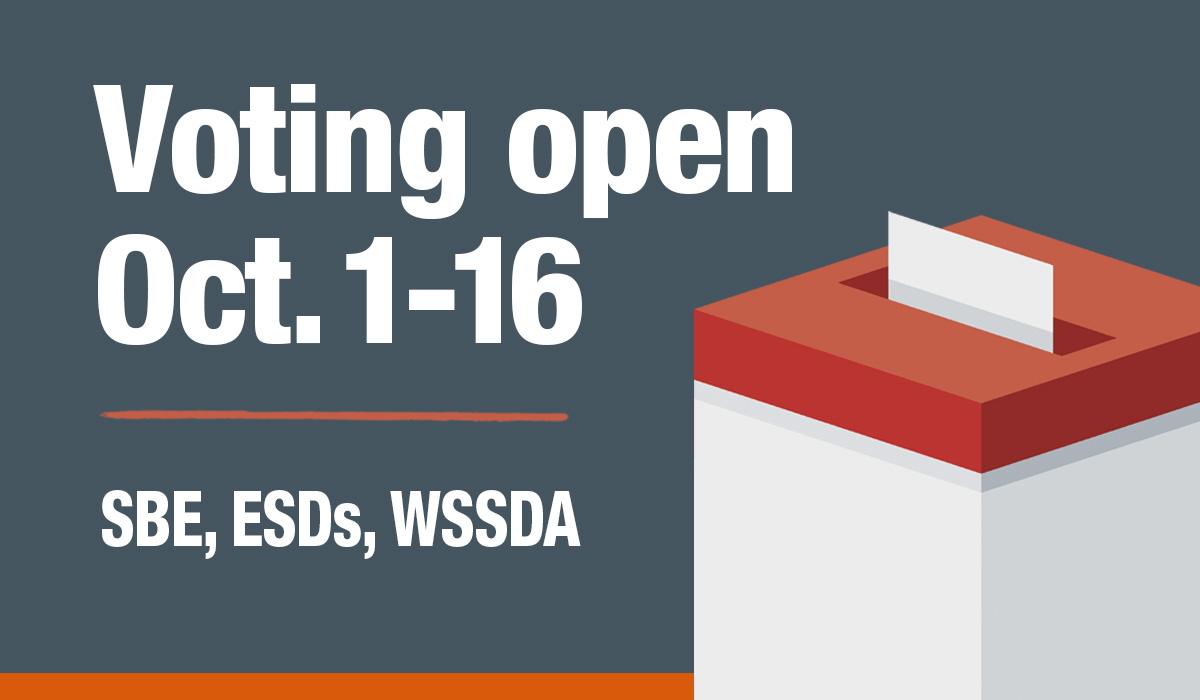
October 1 marks the opening of voting by school directors in elections for the boards of Educational Service Districts (ESDs), the State Board of Education (SBE), and the Washington State School Directors’ Association (WSSDA). Elected positions on some WSSDA committees are also up for a vote by school directors. Directors should look to their email inboxes for voting instructions and reminders.
Candidate information is accessible from these election pages:
Voting concludes on October 16, 2023.
Elected Positions in WSSDA
Open positions vary by region, but elected positions within WSSDA include:
- WSSDA Board Officers
- WSSDA Board of Directors
- Resolutions Committee
- Legislative Committee
- Nominating Committee
- Interscholastic Activities Committee
WSSDA’s regions are called “director areas.” These areas closely resemble the maps for Educational Service Districts. Here is a map of WSSDA’s director areas listing the school districts within them.
Belonging, engagement, and student success — Learn more on Sept 12
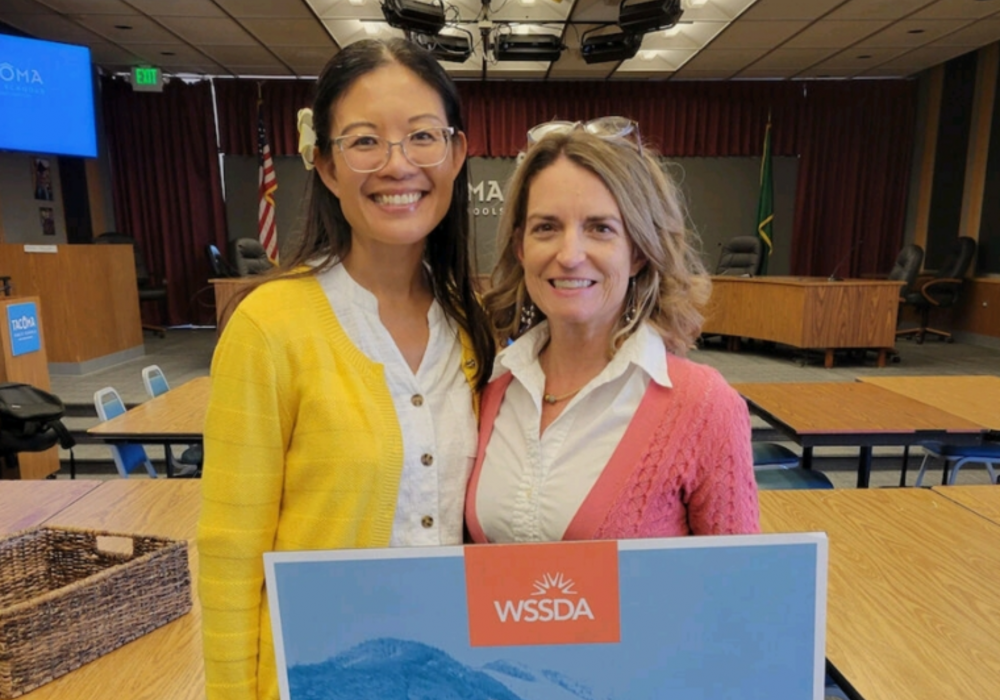
On September 12, the Washington State School Directors’ Association (WSSDA) is offering a virtual learning experience for school directors titled Advancing Inclusion through Belonging. But act fast, because registration closes Sunday night.

“Advancing Inclusion is one of my favorite OnBoard workshops to facilitate,” said Cassandra Sage, a leadership development consultant for WSSDA. “It affirms differences and uniqueness as positive assets.”
The workshop will explore how a sense of belonging leads to increased engagement by students, which leads to more positive outcomes in their educational experience. A key component of that recipe is a sense of dignity and how affirming or violating it will impact students, their families or caregivers, and even district staff.
“I wish this training was offered when I was a director because equity is not an easy word to define and measure,” said Vanessa Edwards, another WSSDA leadership consultant who facilitates training. “Advancing Inclusion Through Belonging will help you connect student belonging, outcomes, and how you, as a director, can impact it all. We all walk away with a deeper understanding and ideas on how to make positive changes within our districts.”
The training will be offered again this fall, but seats are filling up, and at the WSSDA Annual Conference, seats for Advancing Inclusion are already filled. Interested school directors are encouraged to register as soon as possible. All scheduled trainings can be found at wssda.org/training.
